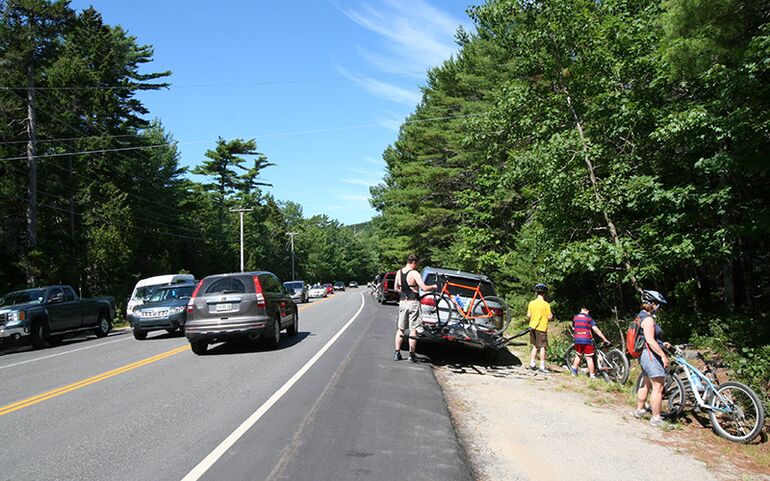
Acadia transportation plan includes reservations, restrictions on parking
 Photo / Laurie Schreiber
Visitors on a summer day prepare to bike on carriage roads around Acadia's popular Eagle Lake. Parking spillover onto the road results from Eagle Lake's two parking lots being full.
Photo / Laurie Schreiber
Visitors on a summer day prepare to bike on carriage roads around Acadia's popular Eagle Lake. Parking spillover onto the road results from Eagle Lake's two parking lots being full.
Acadia National Park’s final plan, designed to address congestion and transportation, includes a timed-entry reservation system for three of the park’s most popular spots during peak season and a phase-out of right-lane parking on Loop Road.
Full implementation of the plan is likely to take up to a decade or more, though initial work may begin in 2020, according to a news release.
Next steps following this week’s release of the plan and an accompanying environmental impact statement are preparation of a Record of Decision for review and approval by Regional Director Gay Vietzke.
“This plan is a blueprint for the future," said Superintendent Kevin Schneider. "Many of the details related to implementation of the Final Plan/EIS will take years and continue to require public feedback and stakeholder engagement"
Key provisions

Key provisions of the plan include:
• Timed-entry reservation system for the Ocean Drive (Loop Road) corridor, Cadillac Summit Road and the Jordan Pond House North Lot during peak season. The number of reservations available would correspond with management actions needed to manage within the desired resource and experiential conditions and the identified visitor capacities. A percentage of reservations would be held aside for short-term purchase. Reservations could be made online and at automated reservation kiosks in key locations.
• Right-lane parking would be retained in the near term but eventually phased out as other options, such as expanded Island Explorer service and additional parking areas at Hulls Cove and the Acadia Gateway Center, become available.
• The parking lot and restroom on the north side of Route 233 at Eagle Lake would be removed and a new larger parking lot would be constructed south of the highway at a National Park Service maintenance storage yard known as Liscomb Pit.
• Additional parking would be provided at Hulls Cove, and the visitor center would be redesigned and relocated on site, but on grade with the parking lot.
• Visitor services at the Thompson Island Information Center (on the west side of Route 3) would no longer be needed after construction of the Acadia Gateway Center in Trenton. These services would be relocated to the Gateway Center and the structures would be removed so the area could be restored to natural conditions.
• During initial implementation of the plan, parking lots would continue to be managed on a first-come, first-served basis; however, if monitoring by park officials indicates traffic or resource conditions are worsening beyond acceptable thresholds, access to Island Explorer routes entering the park, vehicle access to other parking lots or vehicle access to the entire Park Loop Road may be added to the reservation system.
• Island Explorer service inside the park would be expanded as necessary up to the park’s visitor capacity and, as funding allows, would facilitate access for those unable to secure a vehicle reservation during their desired entry time. The operating season of Island Explorer service would be expanded to coincide with that of the reservation system.
• Increased information would be provided to visitors, both before they arrive at the park and upon arrival.
• To improve safety and the historic character of Park Loop Road, only vehicles that fit the geometry of the road and heights of the bridge underpasses would be permitted. This requirement would apply to passenger and commercial vehicles and would be phased in over several years.
• During the reservation season, the number of oversize commercial vehicles allowed at key locations at one time would be managed to ensure desired conditions are maintained and visitor capacities at the park’s primary attractions are not exceeded.
• The Schoodic Peninsula would continue to be managed as outlined in the 2005 Schoodic General Management Plan Amendment.
The plan says there will be both beneficial and adverse affects on visitor access and visitor experience, but overall, most are expected to be beneficial. It’s expected to enhance the quality of the experience along key corridors and destinations.
The reservation system would “result in a significant adverse impact on the historic character of Park Loop Road because it creates a segmented driving experience counter to its historic design,” the plan says. “It also involves some construction of modern infrastructure that detracts from the historic character of the road and cultural landscape.”
However, the eventual elimination of right-lane parking on the Loop Road is expected to be a major beneficial impact, resulting in improvements in visitor experience and access and long-term beneficial impacts on the local and regional tourism industry.
The plan is the culmination of a planning effort that began in summer 2015 and included input by neighboring town governments, chambers of commerce, industry partners, communities, stakeholders, National Park Service staff and the public.
Acadia visitorship continues to rise. In 2017, Acadia had 3.5 million visitors, up from 3.3 million the previous year, according to the park service. Through Aug. 30, Acadia had 2.39 million visitors, up from 2.34 million through the first eight months of 2017.
Coming off a strong 2018, Acadia received federal funding to upgrade the Island Explorer fleet of free shuttle buses. Island Explorer — a seasonal service that serves the park and is owned and operated by Ellsworth's Downeast Transportation — has 21 new buses on order for 2019.









0 Comments